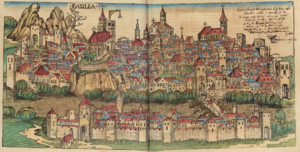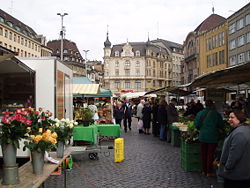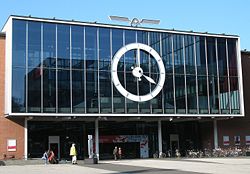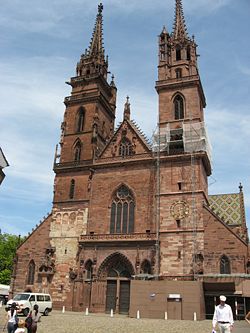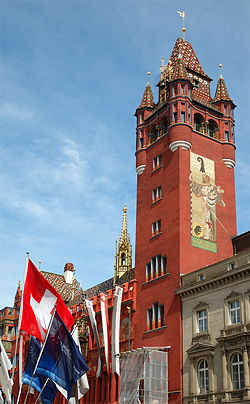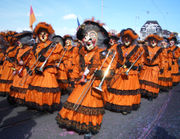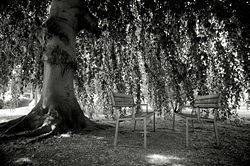Basel
2008/9 Schools Wikipedia Selection. Related subjects: Europe; European Cities
| Basel | ||||||||||
|---|---|---|---|---|---|---|---|---|---|---|
|
||||||||||
| Population | 165,529 (December 2006) | |||||||||
| - Density | 7,276 /km² (18,845 /sq.mi.) | |||||||||
| Area | 22.75 km² (8.8 sq mi) | |||||||||
| Elevation | 260 m (853 ft) | |||||||||
| - Lowest | 244.75 m - Rhine shore, national border at Kleinhüningen | |||||||||
| Postal code | 4000 | |||||||||
| Mayor | Guy Morin (as of 2008) GP | |||||||||
| Surrounded by (view map) |
Allschwil (BL), Binningen (BL), Birsfelden (BL), Bottmingen (BL), Huningue (FR-68), Münchenstein (BL), Muttenz (BL), Reinach (BL), Riehen, Saint-Louis (FR-68), Weil am Rhein (DE-BW) | |||||||||
| Website | www.basel.ch | |||||||||
Basel (['ba:zəl], also Basle [bɑːl] , German: Basel ['ba:zəl], French: Bâle [bɑl], Italian: Basilea [bazi'lɛːa], Romansh: Basilea [bazi'lɛːa]) is Switzerland's third most populous city (165,529 inhabitants (2006); 731,000 inhabitants in the metropolitan area stretching across the immediate cantonal and national boundaries made Basel Switzerland's second-largest urban area as of 2004.
Located in north-west Switzerland on the river Rhine, Basel functions as a major industrial centre for the chemical and pharmaceutical industry. The city borders both Germany and France. The Basel region, culturally extending into German Baden-Württemberg and French Alsace, reflects the heritage of its three states in the modern Latin name: " Regio TriRhena". It has the oldest university of the Swiss Confederation (1460).
History
During the days of the Roman Empire, the settlement of Augusta Raurica was founded 10 or 20 kilometres upstream of present Basel, and a castle was built on the hill overlooking the river where the Basel Münster now stands. But even older Celtic settlements (including a vitrified fort) have been discovered recently in the area predating the Roman castle. The city's position on the Rhine long emphasised its importance: Basel for many centuries possessed the only bridge over the river "between Lake Constance and the sea".
The town of Basel was called "Basilia" in Latin, and this name is documented from the year 374 AD. Since the donation of the Abbey Moutier-Grandvalto and all its possessions to Bishop Adalbero II. in 999 till the Reformation, Basel was ruled by prince-bishops (see Bishop of Basel, whose memory is preserved in the crosier shown on the Basle coat-of-arms - see above). In 1019 the construction of the cathedral of Basel (known locally as the Münster) began under German Emperor Heinrich II. In 1225–1226 the Bridge over the Rhine was constructed by Bishop Heinrich von Thun and lesser Basel (Kleinbasel) founded as a beachhead to protect the bridge.
In 1356 the Basel earthquake destroyed much of the city along with a number of castles in the vicinity. The city offered courts in the city to nobles as an alternative to rebuilding their castles, in exchange for the nobles' military protection of the city.
In 1412 (or earlier) the well-known guesthouse Zum Goldenen Sternen was established. Basel became the focal point of western Christendom during the 15th century Council of Basel (1431 –1449), including the 1439 AD election of antipope Felix V. In 1459 Pope Pius II endowed the University of Basel where such notables as Erasmus of Rotterdam, Paracelsus and Hans Holbein the Younger taught. At the same time the new craft of printing was introduced to Basel by apprentices of Gutenberg.
The Schwabe publishing house was founded 1488 by Johannes Petri and is the oldest publishing house still in business. Johann Froben also operated his printing house in Basel and was notable for publishing works by Erasmus. In 1495, Basel was incorporated in the Upper Rhenish Imperial Circle, the bishop sitting on the Bench of the Ecclesiastical Princes. In 1500 the construction of the Basel Münster was finished. In 1501 Basel de facto separated from the Holy Roman Empire and joined the Swiss Confederation as 11th canton, and began the construction of the city council building. The bishop continued to reside in Basel until the reformation of Oecolampadius in 1529. The bishop's crook was however retained as the city's coat of arms. In March 1536 the first edition of Christianae religionis institutio ( Institutes of the Christian Religion) was published in Latin by John Calvin at Basel. There are indications Joachim Meyer, an influential 16th century author of a book on fighting ( kunst des Fechten) came from Basel.
Intended as a defence of Huguenots then persecuted in France, Calvin's Institutes was an exposition of Protestant Christian doctrine which later became known as Calvinism. In 1543 De humani corporis fabrica, the first anatomy book was published and printed in Basel by Andreas Vesalius (1514–1564). In 1662 the Amerbaschsches Kabinett formed the basis of a collection and exposition, forming the core of the Basel Museum of Art.
In 1792 the Republic of Rauracia, a revolutionary French client republic, was created. It lasted until 1793. After three years of political agitation for equal rights and a short civil war in 1833 the disadvantaged countryside seceded from the Canton of Basle, forming the halfcanton of Basel-Landschaft. In 1912, the extraordinary congress of the Second International was held in Basel, due to the outbreak of the Balkan Wars
Accords
Throughout history, Basel has seen the conclusion of numerous accords. In 1499 Treaty of Basel was signed, ending the Swabian War, and two years later Basel joined the Swiss Confederation. In 1795, two separate peace treaties between the revolutionary French Republic on the one hand and Prussia and Spain on the other brought about the collapse of the First Coalition and the cessation of fighting in the French Revolutionary Wars. In more recent times, on September 3, 1897, the World Zionist Organization held its first congress in Basel under the leadership of Theodor Herzl; this Jewish umbrella organization would later play an instrumental role in the creation of the state of Israel. Because of the Balkan Wars the Second International held an extraordinary congress at Basel in 1912. In 1989, the Basel Convention was opened for signature with the aim of preventing the export of hazardous waste from wealthy to developing nations for disposal.
Industry and trade
An annual Federal Swiss trade fair (Mustermesse) takes place in Kleinbasel on the right bank of the Rhine. Other important trade shows include " BaselWorld" (watches and jewelry), Art Basel, Orbit and Cultura.
The Swiss chemical industry operates largely from Basel, with Novartis, Syngenta, Ciba Specialty Chemicals, Clariant, and Hoffmann-La Roche headquartered there. Pharmaceuticals and specialty chemicals have become the modern focus of the city's industrial production. Some of the chemical industry's most notable creations include DDT, Araldite, Valium, Rohypnol and LSD.
UBS AG maintains central offices in Basel, giving finance a pivotal role in the local economy. The importance of banking began when the Bank for International Settlements located within the city in 1930. Basel's innovative financial industry includes institutions like the Basel Committee on Banking Supervision. Responsible for the Basel Accords ( Basel I and Basel II) , this organization fundamentally changed Risk Management within its industry.
Basel has Switzerland's tallest building, Basler Messeturm.
Quarters
Basel is subdivided into 19 quarters (Quartiere). The municipalities of Riehen and Bettingen, outside the city limits of Basel, are included in the canton of Basel-City as rural quarters (Landquartiere).
| Quartier | ha | Quartier | ha |
|---|---|---|---|
| Altstadt Grossbasel (central Grossbasel) | 37.63 | Altstadt Kleinbasel (central Kleinbasel) | 24.21 |
| Vorstädte (Suburbs) | 89.66 | Clara | 23.66 |
| Am Ring | 90.98 | Wettstein | 75.44 |
| Breite | 68.39 | Hirzbrunnen | 305.32 |
| St. Alban | 294.46 | Rosental | 64.33 |
| Gundeldingen | 123.19 | Mattäus | 59.14 |
| Bruderholz | 259.61 | Klybeck | 91.19 |
| Bachletten | 151.39 | Kleinhüningen | 136.11 |
| Gotthelf | 46.62 | City of Basel | 2275.05 |
| Iselin | 109.82 | Riehen | 1086.10 |
| St. Johann | 223.90 | Bettingen | 222.69 |
| Canton of Basel-City | 3583.84 |
Architecture
The red sandstone Münster, one of the foremost late-Romanesque/early Gothic buildings in the Upper Rhine, was badly damaged in the great earthquake of 1356, rebuilt in the fourteenth and fifteenth century, extensively reconstructed in the mid-nineteenth century and further restored in the late twentieth century. A memorial to Erasmus lies inside the Münster.
Basel is also host to an array of buildings by internationally renowned architects, such as the Beyeler Foundation by Renzo Piano, or the Vitra complex in nearby Weil am Rhein, composed of buildings by architects such as Zaha Hadid (fire station), Frank Gehry ( design museum), Alvaro Siza Vieira (factory building) and Tadao Ando (conference centre). Basel also features buildings by Mario Botta (Jean Tinguely Museum and Bank of International settlements) and Herzog & de Meuron (whose architectural practice is in Basel, and who are best known as the architects of Tate Modern in London). The city received the Wakker Prize in 1996.
Heritage sites
Basel features a great number of heritage sites of national significance. These include the entire Old Town of Basel as well as the following buildings and collections:
- Churches and monasteries
- Basel Münster, St. Albankirche, Kirche St. Antonius, the former Barfüsserkirche, Elisabethenkirche, Klingentalkirche, Leonhardskirche, Martinskirche, Pauluskirche, Peterskirche, Alt Katholische Predigerkirche, Johanneskirche, Theodorskirche (with Early Middle Age gravefield), the synagogue (1867), the former Kartause (later an orphanage) and the Kleines Klingental (formerly a Dominican monastery).
- Secular buildings
- Haus zum Raben, Dompropstei ( Antikenmuseum), Goldener Sternen, Seidenhof (with a monument to Rudolf von Habsburg), Kleiner Kirschgarten, Im Vogelsang housing estate, Bruderholzschulhaus, Safranzunft, Schloss Gundeldingen, Brunschwilerhaus, Holsteinerhof, Spiesshof, City hall, Geltenzunft, Haus Auf Burg (with Sacher archive), Domhof, Schönes Haus and Schöner Hof, Zerkindenhof, Wildtsches Haus, Blaues Haus ( Reichensteinerhof), Weisses Haus ( Wendelstörferhof), Sandgrube, Bischofshof, Ramsteinerhof, Hohenfirstenhof, Haus zur Mücke, Wohnhaus für alleinstehende Frauen (1928), Feuerschützenhaus, Spalenhof, Lohnhof, Gate of Saint Alban, Gate of Saint John, the city walls with the Letziturm and the inner wall tower, Gate of Spalen, the Hoffmann-La Roche premises, Bürgerspital (1940-45), Badischer Bahnhof with fountain (1913), central railway station (1907), Mittlere Rheinbrücke, Fischmarktbrunnen.
- Archaeological sites
- Gallo-Roman settlement on the Gasfabrik premises, Alemannic burial fields Gotterbarmweg and Kleinhüningen, early medieval buildings Schneidergasse 2-16.
- Museums, archives and collections
- State Archives, Swiss Economic Archives, University library, Antikenmuseum, Art Museum and engravings cabinet, Museum of Contemporary Art, Gallizianmühle, Natural History Museum (with Rütimeyer library), Museum of Cultures, Kirschgartenmuseum, Historical Museum, Jewish Museum, Music Museum, Sport Museum, Sculpture Hall, Anatomical collection, Stadt- und Münstermuseum (Kleines Klingental), Gewerbemuseum, Pharmazie-Historisches Museum, Caricature and Cartoon Museum.
Education
Basel hosts Switzerland's oldest university, the University of Basel, dating from 1459. Erasmus, Paracelsus, Daniel Bernoulli, Leonhard Euler, Jacob Burckhardt, and Friedrich Nietzsche worked here. More recently, its work in tropical medicine has gained prominence.
Basel is renowned for various scientific societies, as the Entomological Society of Basel (Entomologische Gesellschaft Basel, EGB), which celebrated its 100th anniversary in 2005.
Basel counts several International Schools, including the International School of Basel, the Minerva School and the Rhine Academy. Many expatriate workers and their children come to Basel due to the large presence of pharmaceutical companies, and the majority of those children come to study at the international schools of Basel.
Politics
Geo-politically, the city of Basel functions as the capital of the Swiss half-canton of Basel-Stadt, though several of its suburbs form part of the half-canton of Basel-Landschaft or of the canton of Aargau (or of France or Germany).
Notable people from Basel
- Karl Barth (1886-1968), Reformed Protestant theologian
- Daniel Bernoulli (1700-1782) mathematician
- James Bernoulli (1654-1705), mathematician
- Johann Bernoulli (1667-1748), mathematician
- Peter Birkhäuser (1911-1976), painter
- Jacob Burckhardt (1818-1897), professor in history, theology, philosophy
- Arthur Cohn (1927- ), film producer
- Erasmus (c1466-1536), biblical scholar, humanist, theologian
- Leonhard Euler (1707-1783), mathematician
- Roger Federer (1981- ), tennis player
- Katy French (1983-2007), model and socialite
- Jakob Emanuel Handmann (1718-1781), painter
- Johann Peter Hebel (1760-1826), poet & author
- Albert Hoffman (1906-2008), chemist, inventor of LSD
- Ana Ivanovic (1987), female tennis player, winner of the 2008 French Open
- Lucius Munatius Plancus (c.87 BC - c.15 BC), city founder
- Joachim Meyer (c. 1537?-1571), fencer and author
- Frithjof Schuon (1907-1998), religious philosopher
Culture
Basel has a reputation as one of the most important cultural cities in Europe. In 1997, it contended to become the " European Capital of Culture". In May 2004, the fifth EJCF choir festival opened: this Basel tradition started in 1992. Host of this festival is the local Basel Boys Choir.
The carnival of the city of Basel ( Basler Fasnacht) is a major cultural event in the year. The carnival is the biggest in Switzerland and attracts large crowds every year, despite the fact that it starts at four in the morning (Morgestraich) and lasts for exactly 72 hours, taking in various parades.
For more information see also "Welcome to Basel Fasnacht", February 2001
Basler Zeitung ("Baz") is the local newspaper.
Museums
The Basel museums cover a broad and diverse spectrum of collections with a marked concentration in the fine arts. They house numerous holdings of international significance. The over three dozen institutions yield an extraordinarily high density of museums compared to other cities of similar size and draw over one million visitors annually.
Constituting an essential component of Basel culture and cultural policy, the museums are the result of closely interwoven private and public collecting activities and promotion of arts and culture going back to the 16th century. The public museum collection was first created back in 1661 and represents the oldest public collection in continuous existence. Since the late 1980s, various private collections have been made accessible to the public in new purpose-built structures that have been recognized as acclaimed examples of avant-garde museum architecture.
- Antikenmuseum Basel und Sammlung Ludwig Ancient cultures of the mediterranean museum
- Augusta Raurica Roman open-air museum
- Basel Paper Mill (German: Basler Papiermühle)
- Beyeler Foundation (Fondation Beyeler) Beyeler Museum (Fondation Beyeler)
- Botanical Garden Basel One of the oldest botanical gardens in the world
- Caricature & Cartoon Museum Basel (German: Karikatur & Cartoon Museum Basel)
- Dollhouse Museum (German: Puppenhausmuseum)
- Historical Museum Basel (German: Historisches Museum Basel)
- Kunsthalle Basel Modern and contemporary art museum
- Kunstmuseum Basel Upper Rhenish and Flemish paintings, drawings from 1400 to 1600 and 19th- to 21st-century art
- Monteverdi Automuseum
- Museum of Cultures Basel (German: Museum der Kulturen Basel) Large collections on European and non-Europeancultural life
- Museum of Contemporary Art Art from the 1960s up to the present
- Music Museum (German: Musikmuseum) of the Basel Historic Museum
- Natural History Museum of Basel (German: Naturhistorisches Museum Basel)
- Pharmazie-Historisches Museum der Universität Basel
- Schaulager Modern and contemporary art museum
- Swiss Architecture Museum (German: Schweizerisches Architekturmuseum)
- Tinguely Museum Life and work of the major Swiss iron sculptor Jean Tinguely
- Vitra Design Museum Museum in Weil am Rhein near Basel
Chronological table
| Year | Event |
|---|---|
| < 58 BC | Rauracian (Celtic) agglomeration on the Rhine |
| 58 BC | Exodus of the Helvetians and Rauracians (Battle of Bibracte) |
| 44-43 BC | Lucius Munatius Plancus founds the Roman colony Colonia Raurica, that will later become colonia Augusta Raurica |
| 12 BC | The oppidum of Basel is one of the supporting points for the Roman troops during the campaigns of Tiberius against the Rhaetians |
| 1st century | Occupation of the Agri Decumates (southern Germany); the Roman fortified place of Basel becomes a vicus. |
| 3rd century | Alemanni invasions. The Roman Vicus of Basel becomes again a fortified place |

![Basel [zoom] (Switzerland)](../../images/601/60121.png)
